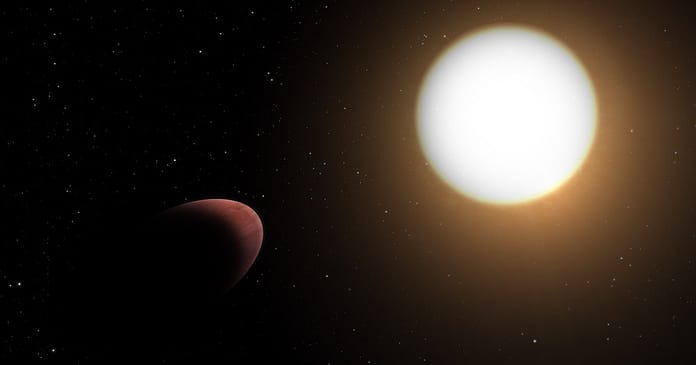Elliptical instead of circular: Astronomers have noticed for the first time a clearly distorted exoplanet – WASP-103b looks like a rugby ball rather than a sphere. This distortion is caused by the strong tidal forces of the parent star. Since the planet orbits so closely, stellar gravity separates them from each other. However, it is puzzling why this exoplanet appears to be moving away from its star rather than increasingly attracted to it.
Tidal forces always arise when the gravity of one celestial body acts on another. In this way, tides arise on the Earth due to the attraction of the Moon. However, the effects are much stronger when they are caused by stars or gas giants like Jupiter. Jupiter’s massive tidal forces run through the interiors of its nearby moons and generate heat, which is expressed on Io in violent volcanoes and in Europe gave rise to subglacial ocean and possibly submarine volcanoes.
The effects should be more severe with hot Jupiters — gas giants outside the solar system that orbit their stars very closely. Astronomers have long suspected that such exoplanets must be deformed by the ovals of their star’s tidal forces. But until now, it has never been possible to prove this effect.
Light curve reveals deformation
Now that has changed: For the first time, astronomers have observed an exoplanet significantly distorted by the tidal forces of its star. Planet WASP-103b is a hot Jupiter in the constellation Hercules, whose parent star is about 1.7 times larger and slightly hotter than our Sun. Like other hot Jupiter, the exoplanet orbits its star in a very narrow orbit and only takes one day to complete one orbit.
To see the consequences for the planet, astronomers working with Susana Barros of the University of Porto targeted WASP-103b with the CHEOPS space telescope. This telescope is designed to record the transit of exoplanets in front of their star with high accuracy. Using the resulting light curve, not only the size and orbit of the planet can be determined, but also whether the planet is round or distorted.
At WASP-103b, researchers analyzed CHEOPS light curves from twelve transits and also evaluated data from the Hubble and Spitzer Space Telescopes.

Rugby ball instead of the ball
In fact, the data revealed: the exoplanet WASP-103b is warped. As a result of strong tidal forces, it looks more like an oval rugby ball than a ball. “It is incredible that CHEOPS was able to demonstrate this distortion,” says co-author Jacques Laskar of the Sorbonne Observatory in Paris. This is because such deformation can only be observed in the light curve in the form of small deviations.
This is the first time astronomers have directly proven that an exoplanet has been distorted by the tidal force of its star. From how deformed WAPS-103b is, its size and estimated mass, astronomers have also been able to obtain information about its internal structure. “The resistance of a material to deformation depends on its composition,” explains co-author Babatunde Akinsanmi from the University of Geneva. “By measuring how deformed a planet is, we can thus determine how much of it is rock, gas, or water.”
This data revealed that while WASP-103b should be constructed similarly to Jupiter, it is severely bloated. The cause of this bloating is still not clear.
orbital drift puzzle
The effect of stellar gravity on the orbit of WASP-103b is also unclear. According to the theory, the star’s strong gravitational pull should also affect the orbit of such a nearby planet – it should spiral upwards more and more narrowly. At some point, the planet will get so close to its star that it will be torn apart and devoured by its gravity.
In the case of WASP-103b, the team of astronomers was unable to find any clear indications of such a narrowing of the orbit – on the contrary. “There is little evidence that the orbital period is lengthening, which is contrary to expectations,” Barros and colleagues explain. However, it remains to be clarified whether the exoplanet is actually drifting away from its star or whether the data is the result of statistical artefacts and other measurement-related anomalies. (Astronomy and Astrophysics, 2022; doi: 10.1051/0004-6361/202142196)
Source: European Space Agency (ESA), University of Bern







